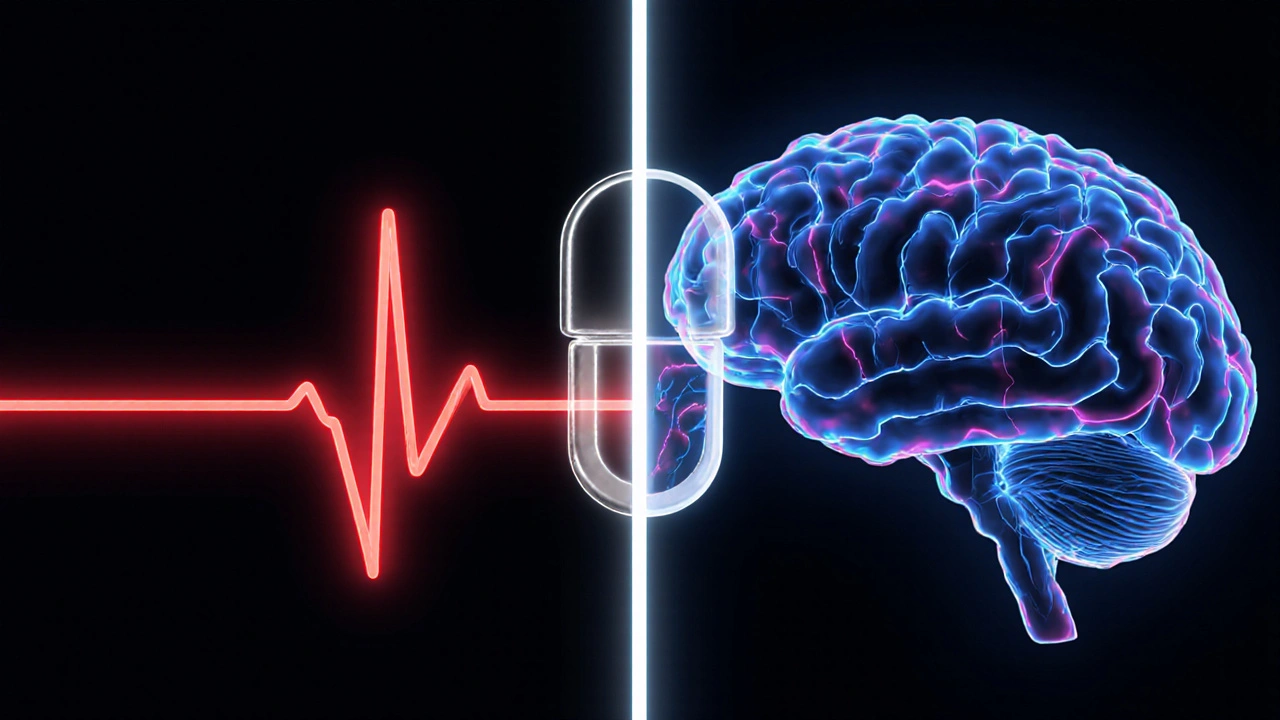Clofranil vs. Alternatives Comparison Tool
Select one or more medications to compare their features:
Select medications to view detailed comparison
Mechanism of Action
How each medication affects brain chemistry. TCAs like Clofranil affect serotonin and norepinephrine; SSRIs target serotonin only; SNRIs affect both.
Efficacy for OCD
Clinical evidence shows varying response rates. Clofranil is often effective when SSRIs fail, but individual responses vary significantly.
Side Effect Burden
TCAs carry more serious cardiac risks. SSRIs generally have fewer severe side effects but may cause sexual dysfunction or weight changes.
Drug Interactions
TCAs interact with many medications including antihistamines and certain antibiotics. SSRIs and SNRIs have fewer interactions but still require caution.
When deciding how to treat obsessive‑compulsive disorder (OCD) or chronic anxiety, many patients encounter Clofranil (Clomipramine) - a tricyclic antidepressant that’s been on the market for decades. While Clofranil works well for many, it also brings a distinct side‑effect profile that can be a dealbreaker. Below you’ll find a straight‑forward look at how Clofranil stacks up against the most common alternatives, so you can weigh benefits, risks, and practical considerations before making a choice.
Why Compare Clofranil With Other Options?
Every medication targets brain chemistry a bit differently. Some people respond better to selective serotonin reuptake inhibitors (SSRIs), while others need the broader neurotransmitter reach of tricyclics. Understanding the differences helps you avoid trial‑and‑error cycles that waste months of treatment time.
Key Decision Factors
- Mechanism of action: Does the drug focus on serotonin alone, or also affect norepinephrine and other pathways?
- Efficacy for OCD: Clinical trials and real‑world studies show varying response rates.
- Side‑effect burden: Weight gain, sexual dysfunction, sedation, cardiovascular risks, etc.
- Drug interactions: Especially important for patients on multiple prescriptions.
- Onset of benefit: Some drugs may take weeks, others months.
Top Alternatives to Clofranil
Below are the six most frequently prescribed alternatives, each introduced with concise microdata markup.
Fluoxetine - an SSRI known for its long half‑life, often used as a first‑line OCD treatment.
Sertraline - another SSRI with robust data supporting its use in both OCD and panic disorder.
Paroxetine - an SSRI that’s especially potent for anxiety‑related symptoms.
Venlafaxine - a serotonin‑norepinephrine reuptake inhibitor (SNRI) offering a middle ground between SSRIs and TCAs.
Imipramine - a classic tricyclic similar to Clofranil but with a slightly different side‑effect spectrum.
Cognitive Behavioral Therapy (CBT) - not a drug, but a proven non‑pharmacological alternative that can be combined with any medication.

Side‑by‑Side Comparison Table
| Medication | Class | Typical Uses | Mechanism | Common Side Effects | Dosage Range | Pros | Cons |
|---|---|---|---|---|---|---|---|
| Clofranil | Tricyclic Antidepressant (TCA) | OCD, Depression, Panic | Blocks serotonin & norepinephrine reuptake | Dry mouth, constipation, weight gain, cardiac concerns | 25‑250mg/day | High efficacy for OCD, works when SSRIs fail | Cardiac monitoring needed, more drug interactions |
| Fluoxetine | SSRI | OCD, Depression, Bulimia | Selective serotonin reuptake inhibition | Insomnia, GI upset, sexual dysfunction | 20‑80mg/day | Long half‑life reduces withdrawal risk | May cause agitation in some patients |
| Sertraline | SSRI | OCD, Depression, PTSD | Selective serotonin reuptake inhibition | Diarrhea, dizziness, sexual dysfunction | 50‑200mg/day | Well‑studied for OCD, fairly tolerable | Can cause mild weight loss in some |
| Paroxetine | SSRI | Anxiety disorders, OCD, Depression | Selective serotonin reuptake inhibition | Weight gain, sexual dysfunction, withdrawal syndrome | 20‑60mg/day | Strong anxiety relief | Higher discontinuation rates |
| Venlafaxine | SNRI | Depression, Anxiety, OCD (off‑label) | Inhibits serotonin & norepinephrine reuptake | Elevated blood pressure, nausea, insomnia | 75‑375mg/day | Addresses both serotonin and norepinephrine pathways | Blood pressure monitoring required |
| Imipramine | Tricyclic Antidepressant (TCA) | Depression, Enuresis, Chronic pain | Blocks serotonin & norepinephrine reuptake | Dry mouth, blurred vision, cardiac effects | 75‑300mg/day | Effective when SSRIs are insufficient | Similar cardiac monitoring to Clofranil |
When Clofranil Might Be the Right Choice
If you’ve tried two different SSRIs at therapeutic doses and still see only marginal improvement, Clofranil can be a game‑changer. Its dual‑reuptake inhibition often captures residual obsessive thoughts that serotonin‑only drugs miss. Patients with comorbid depression and OCD also report higher remission rates on Clofranil.
However, you’ll need baseline ECG monitoring, especially if you’re over 40 or have a family history of heart disease. The medication can also interact with antihistamines, certain antibiotics, and other serotonergic agents, so a thorough medication review is essential.
When to Choose an SSRI Instead
SSRIs such as Fluoxetine or Sertraline are usually first‑line because they have a cleaner side‑effect profile and don’t require cardiac monitoring. If you’re generally healthy, have mild‑to‑moderate OCD, or are pregnant, starting with an SSRI is often recommended.
Patients who are sensitive to sexual side effects may prefer Venlafaxine because its impact on sexual function is less pronounced for many, though the trade‑off is the need for blood pressure checks.

Non‑Pharmacological Alternative: CBT
Even the most powerful drug can fall short if the underlying thought patterns remain unchecked. Cognitive Behavioral Therapy (CBT), particularly exposure and response prevention (ERP), has been shown to reduce OCD symptoms by up to 60% when paired with medication. For patients who want to minimize drug exposure, a structured CBT program can be the cornerstone of treatment.
Practical Tips for Switching or Combining Therapies
- Consult your prescriber before any change - abrupt discontinuation of Clofranil can cause withdrawal symptoms.
- Cross‑taper when moving to an SSRI: Reduce Clofranil by 25% every week while simultaneously increasing the SSRI dose.
- Monitor vital signs: ECG for TCAs, blood pressure for SNRIs, and weight for SSRIs that cause gain.
- Track side effects using a daily journal; this helps your doctor adjust doses quickly.
- Consider adjunctive CBT early in treatment to boost response rates.
Bottom Line
Choosing between Clofranil alternatives isn’t about picking a “best” drug for everyone - it’s about matching the medication’s strengths to your unique health picture. If you need a potent option after SSRI trials, Clofranil shines; if you prefer a lower‑risk profile, SSRIs or the SNRI Venlafaxine may be smarter. And never underestimate the power of CBT as a partner or even a standalone solution.
Frequently Asked Questions
How long does it take for Clofranil to start working?
Most patients notice a reduction in intrusive thoughts within 4‑6 weeks, though full therapeutic effect can take up to 12 weeks.
Is Clofranil safe for people with heart conditions?
It can be used, but only under strict cardiac monitoring. An initial ECG and periodic follow‑ups are mandatory.
Can I combine Clofranil with an SSRI?
Combining two serotonergic agents raises the risk of serotonin syndrome. If a combo is needed, it must be managed by a specialist with dose adjustments and close monitoring.
What are the most common side effects of Fluoxetine compared to Clofranil?
Fluoxetine typically causes insomnia, gastrointestinal upset, and sexual dysfunction, while Clofranil more often leads to dry mouth, constipation, weight gain, and cardiac concerns.
Is CBT effective without medication for severe OCD?
For many severe cases, CBT alone achieves moderate improvement, but combining it with medication usually yields the highest remission rates.
Edward Glasscote
October 9, 2025 AT 15:40Just a heads‑up, the side‑effects list can feel endless, so keep a log. It helps to notice patterns early.
Gaurav Joshi
October 10, 2025 AT 15:40The comparison feels half‑baked, like it cherry‑picks data that favors newer SSRIs while glossing over the hard realities of TCAs. It’s almost as if the author wants you to avoid the older meds without showing the full picture.
Jennifer Castaneda
October 11, 2025 AT 19:26One cannot ignore the hidden agenda of pharmaceutical giants who push SSRIs as the sole solution while burying the long‑term cardiovascular risks of tricyclics under layers of marketing jargon. The data presented often omits the subtle yet significant cardiac monitoring protocols that are mandatory for drugs like Clofranil. Moreover, the tendency to downplay the anticholinergic burden betrays a systematic bias. It is essential for patients to scrutinize every footnote and ask who benefits from the simplified narrative. Historical studies, many of which are behind paywalls, reveal that the efficacy gap between TCAs and SSRIs is narrower than advertised, especially for treatment‑resistant OCD. Ignoring this fact not only skews informed consent but also fuels a covert push towards newer, more profitable patents.
Annie Eun
October 12, 2025 AT 23:13The saga of choosing the right pill feels like a drama series with too many plot twists; one moment you’re hopeful about a new SSRI, the next you’re battling side‑effects that feel like a bad sequel. Still, the reality is you have to weigh each character’s strengths against the cast’s quirks. When the plot thickens, remember the supporting actor-CBT-can steal the show.
Jay Kay
October 14, 2025 AT 03:00Cool info, love the quick pros and cons list. Gives me a clear snapshot without the fluff
Franco WR
October 15, 2025 AT 06:46I’ve been through the OCD treatment maze for years, and I get how overwhelming these tables can look. What really matters is how each drug sits with your own body chemistry and daily routine. Clofranil’s dual action can be a lifesaver when SSRIs leave you stuck in a loop of intrusive thoughts. At the same time, its anticholinergic side‑effects-dry mouth, constipation, and that dreaded weight gain-can creep up slowly. For anyone with a hidden heart condition, the QT prolongation risk isn’t just a footnote; it can turn a therapeutic plan into a cardiac emergency. That’s why a baseline ECG isn’t optional, it’s a safety net. On the flip side, fluoxetine’s long half‑life means you’re less likely to feel withdrawal pangs if you miss a dose. But don’t be fooled-its activating vibe can spark anxiety in a subset of patients. Sertraline tends to be a middle‑ground choice, often tolerable and effective for many OCD sufferers. Paroxetine packs a punch for anxiety but its weight‑gain and discontinuation syndrome can feel like trading one problem for another. Venlafaxine gives you that serotonin‑norepinephrine boost, yet you’ll need to watch your blood pressure like a hawk. Imipramine mirrors Clofranil in many ways, so the cardiac monitoring conversation repeats. Beyond meds, integrating CBT-even just a few sessions of exposure and response prevention-can slash symptoms dramatically. Think of therapy as the scaffolding that lets the medication do its job without the structure buckling. If you’re switching from a TCA to an SSRI, a gentle cross‑taper over several weeks is the safest route. Bottom line: match the drug’s strengths to your personal health profile, keep a symptom diary, and stay in close contact with your prescriber 🙂.
Rachelle Dodge
October 16, 2025 AT 10:33What an elaborate roadmap-your vivid language turns a dry chart into a navigable journey, reminding us that medicine is as much art as science.
Gaurav Joshi
October 17, 2025 AT 14:20I appreciate the thoughtful addition; it underscores the importance of personalizing treatment while keeping safety protocols front and center.
Elaine Proffitt
October 18, 2025 AT 18:06Monitoring is key especially with TCAs and blood pressure with SNRIs keep an eye on those numbers
Christopher Munt
October 19, 2025 AT 21:53Thanks for the clear rundown.